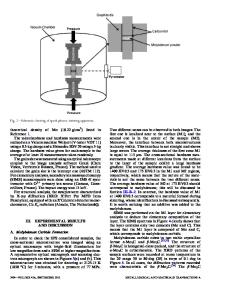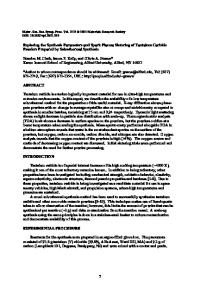Influence of Particle Size on Apparent Diffusivity During Spark Plasma Sintering of Crystalline Powders
- PDF / 2,854,055 Bytes
- 10 Pages / 593.972 x 792 pts Page_size
- 33 Downloads / 384 Views
OWING to a reduction in interfacial energy, raw powders experience changes in structure and shrinkage under the regime of complex densification mechanisms. These in turn are dependent on the average particle size (L), surface energy (c), viscosity (g),[1] and diffusional-related average grain size (a).[2] This dependence is heightened during the early densification stage of neck formation and growth between powder particles. In terms of the individual physicochemical mechanism[3]: the effects of spark generation and sputtering between powder particles,[4] it is specifically attractive of the related densification mechanism and behaviors of powder shrinkage during spark plasma sintering (SPS).
X.X. LI, C. YANG, Z. LIU, and F. WANG are with the National Engineering Research Center of Near-net-shape Forming for Metallic Materials, South China University of Technology, Guangzhou 510640, P.R. China and also with the Guangdong Key Laboratory for Processing and Forming of Advanced Metallic Materials, South China University of Technology, Guangzhou 510640, P.R. China. Contact e-mail: [email protected] Y.Y. LI is with the School of Material Science and Engineering, Huazhong University of Science and Technology, Wuhan 430074, P.R. China. O.M. IVASISHIN is with the Institute for Metal Physics, 36 Vernadsky Str, Kiev 03142, Ukraine. Manuscript submitted April 2, 2019.
METALLURGICAL AND MATERIALS TRANSACTIONS B
Generally, the apparent density decreases with the increasing particle size L. For a given alloy composition, powder particles with different particle sizes would likely have different grain morphologies and a, and consequently different g. Correspondingly, these variations would influence powder shrinkage and thus the underlying densification mechanism during SPS. Studies have demonstrated that the combination of a smaller L and a higher c can accelerate powder densification.[5–8] Densification mechanisms during SPS can be described by various unique physical quantities,[5–13] which are determined by the above powder parameters. Powder shrinkage and densification behaviors during SPS are closely linked to the reduction in total interfacial area and formation of coherent metallurgical bonding between powder particles induced by mass transfer. Recently, a densification-related apparent diffusivity (D), a physical quantity that is direct measure of the role of mass transfer in dominating densification behaviors during SPS, has been determined from the modified creep model (Mukherjee–Bird–Dorn equation).[14] However, for nanocrystalline and the ultra-fine grains, viscous flow dominates shrinkage, especially during the early densification stage.[8,13] Several attempts have been made to correlate the magnitude of particle size with powder shrinkage and densification behaviors during SPS.[15–20] Theoretical analyses have indicated the presence of localized overheating (DT) on contact surfaces of powder particles given the individual physicochemical mechanism during SPS, which can cause thermal softening and localized melting, thereby enhancing the
Data Loading...











